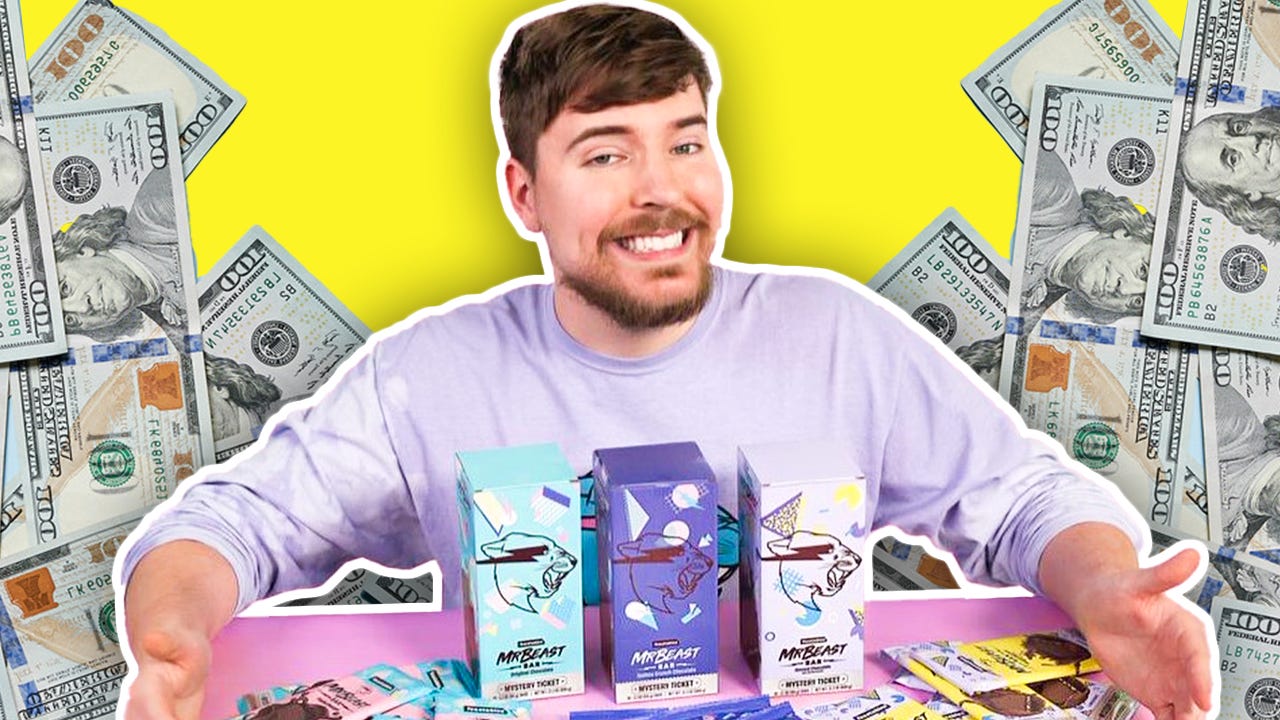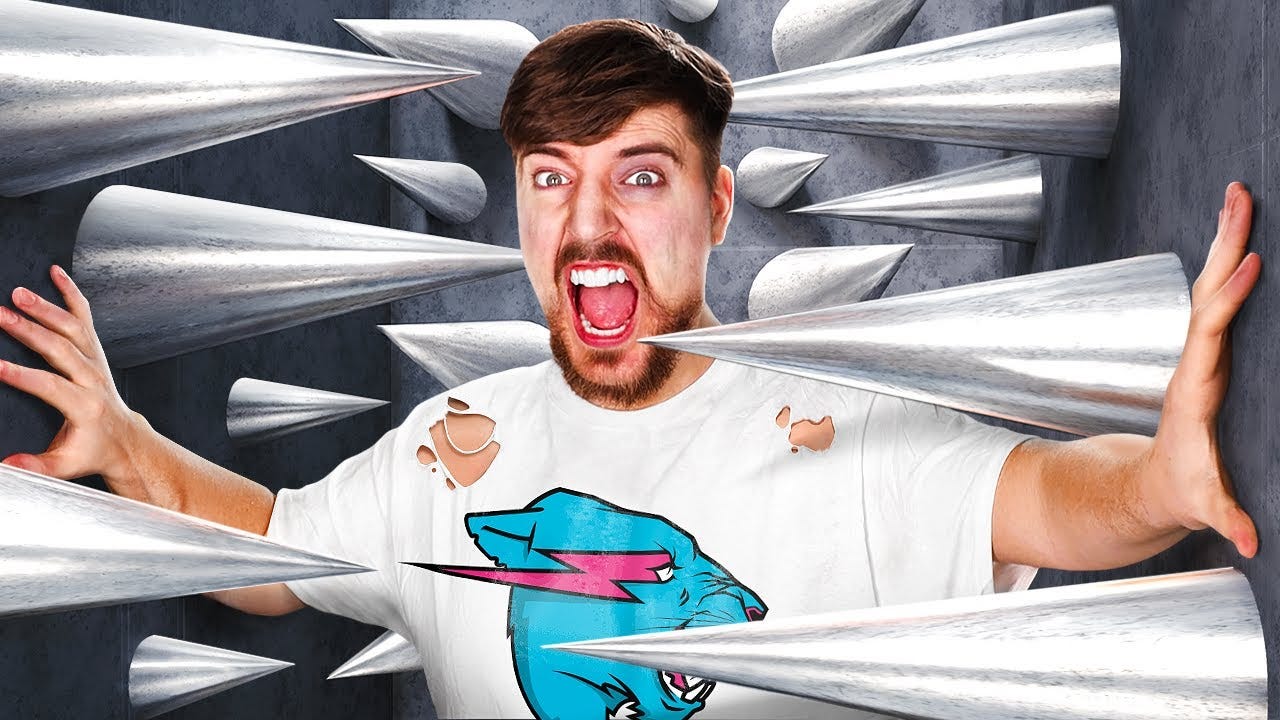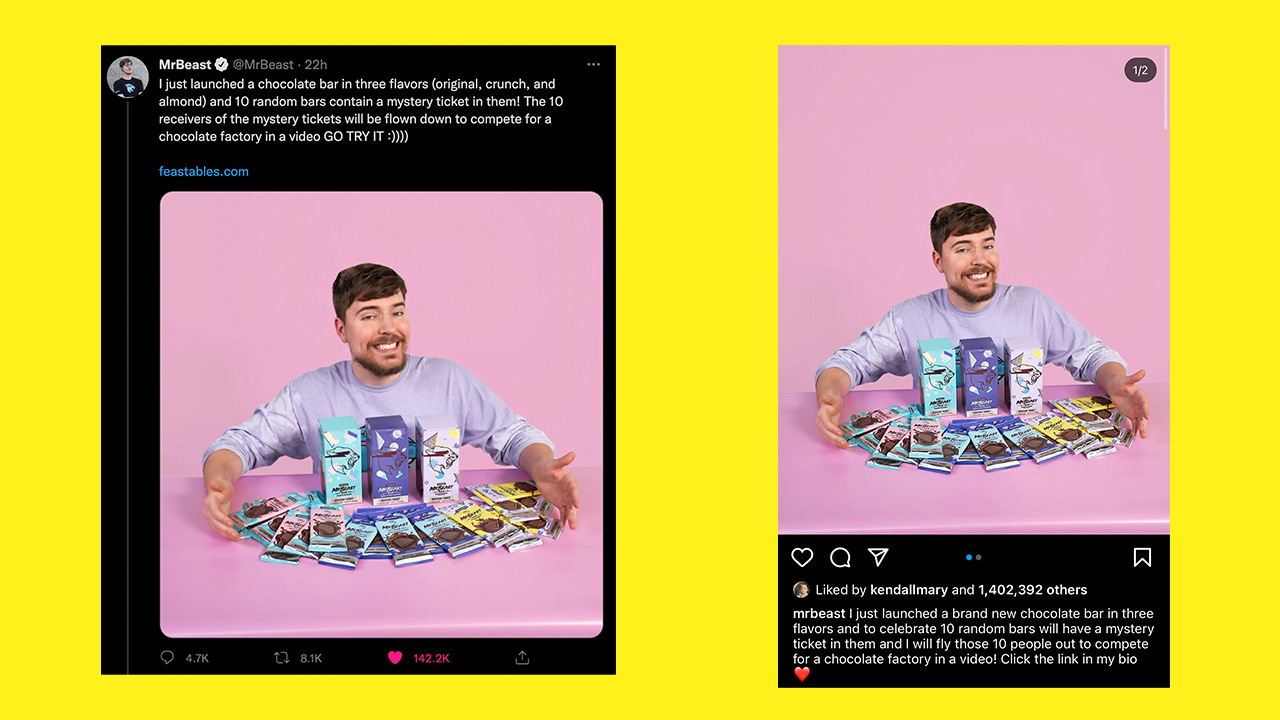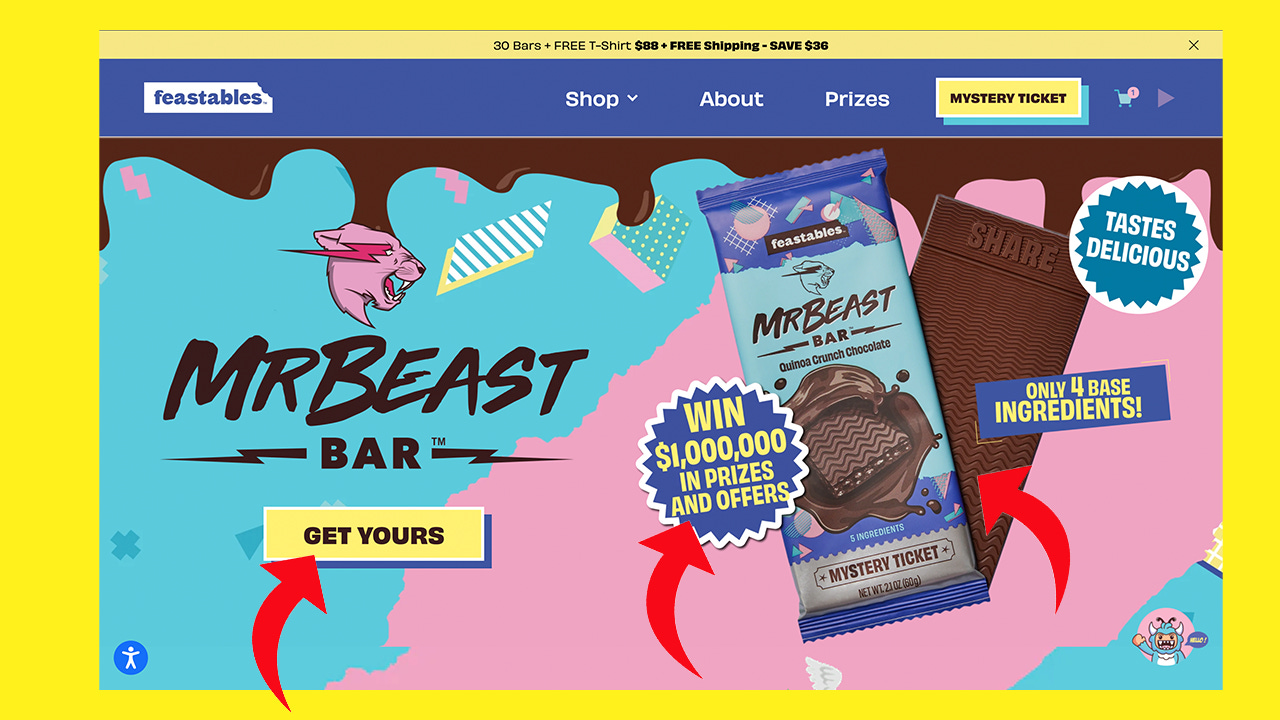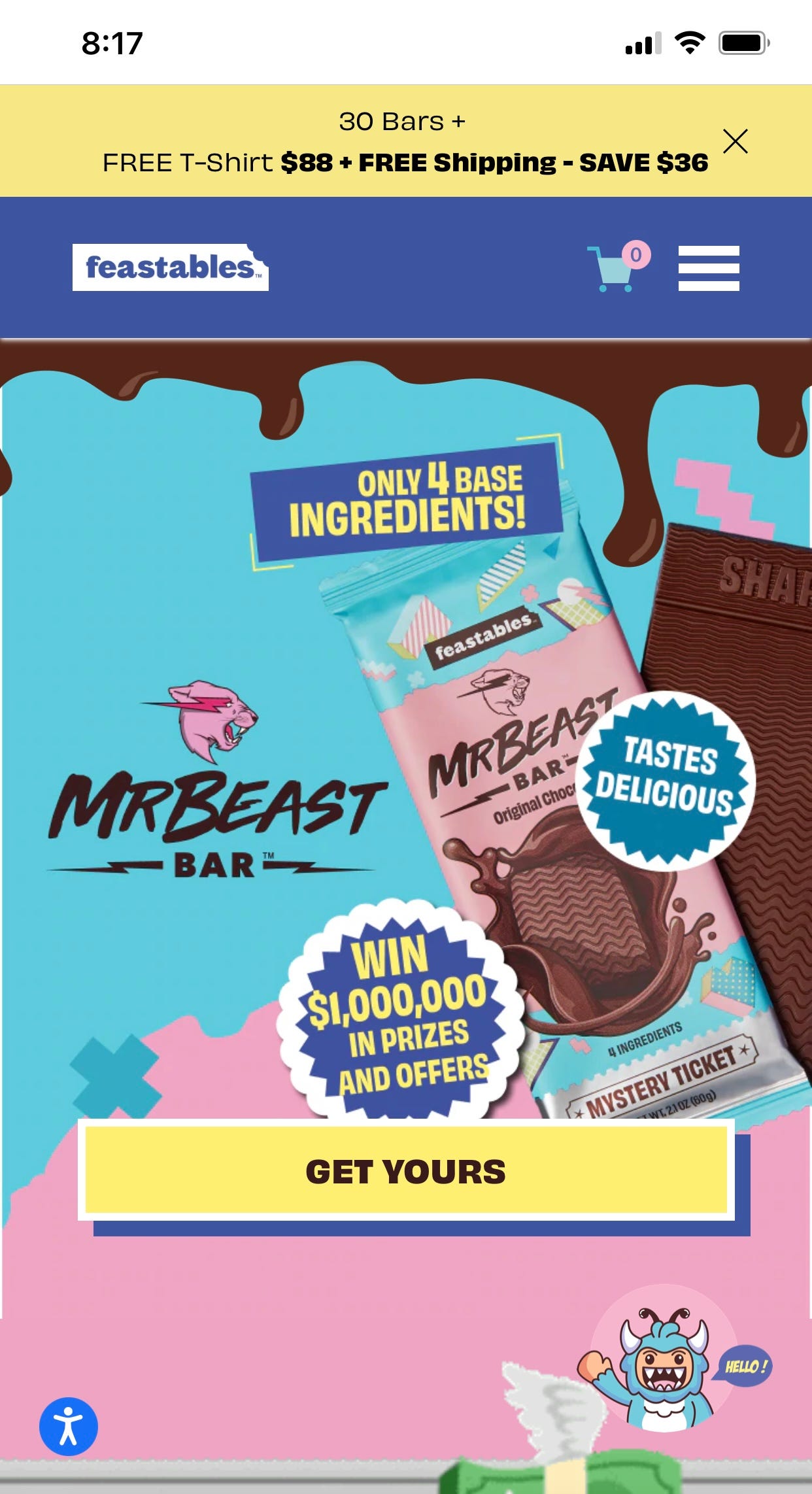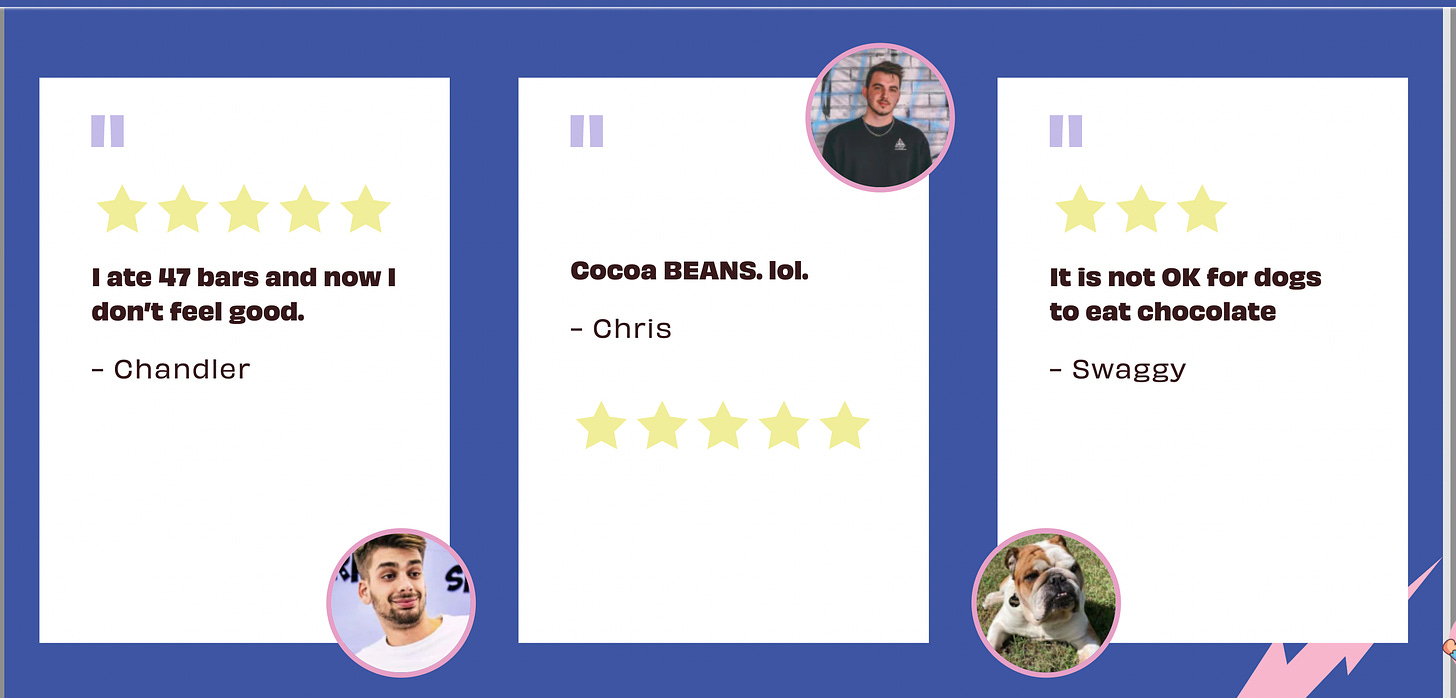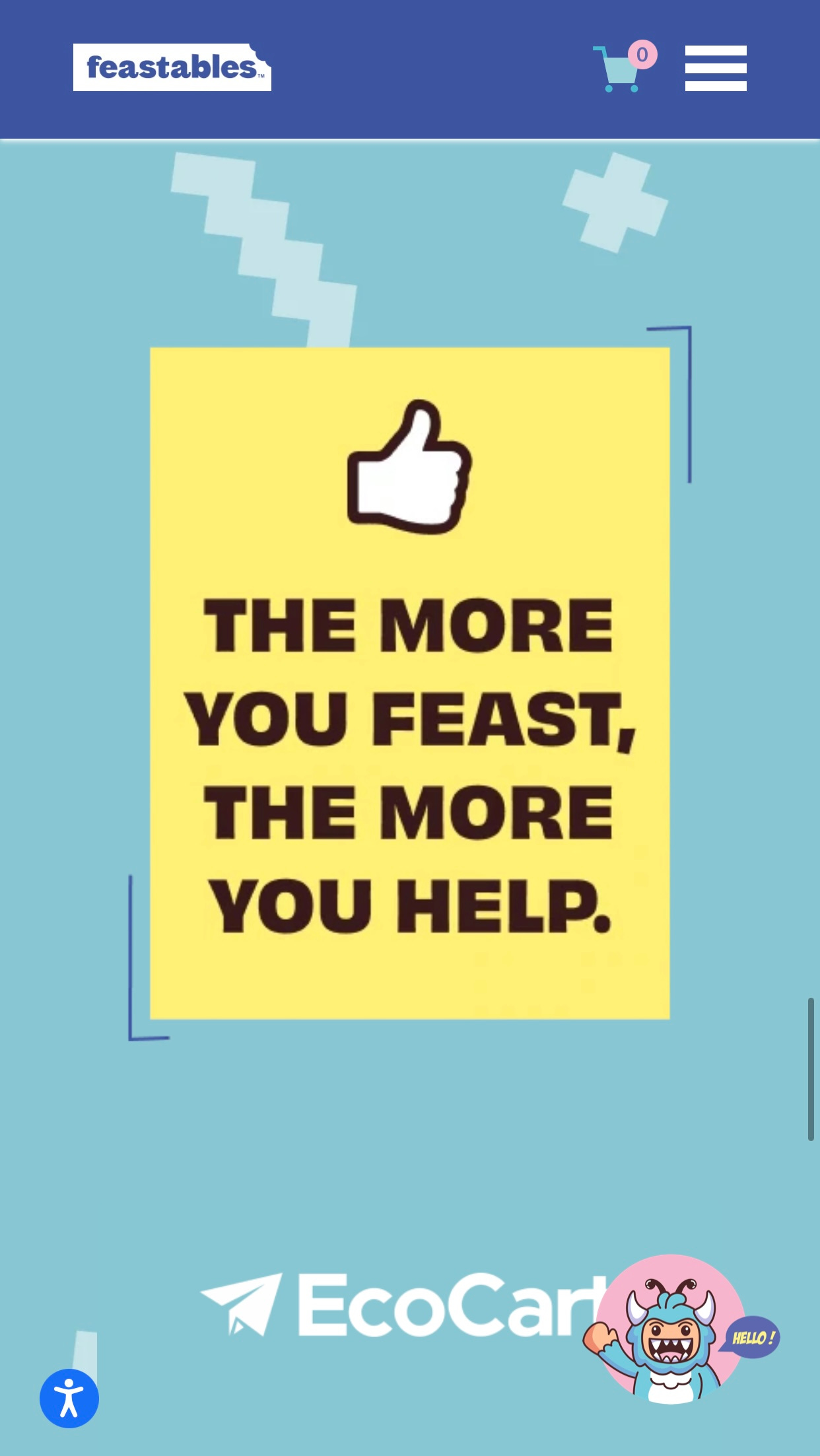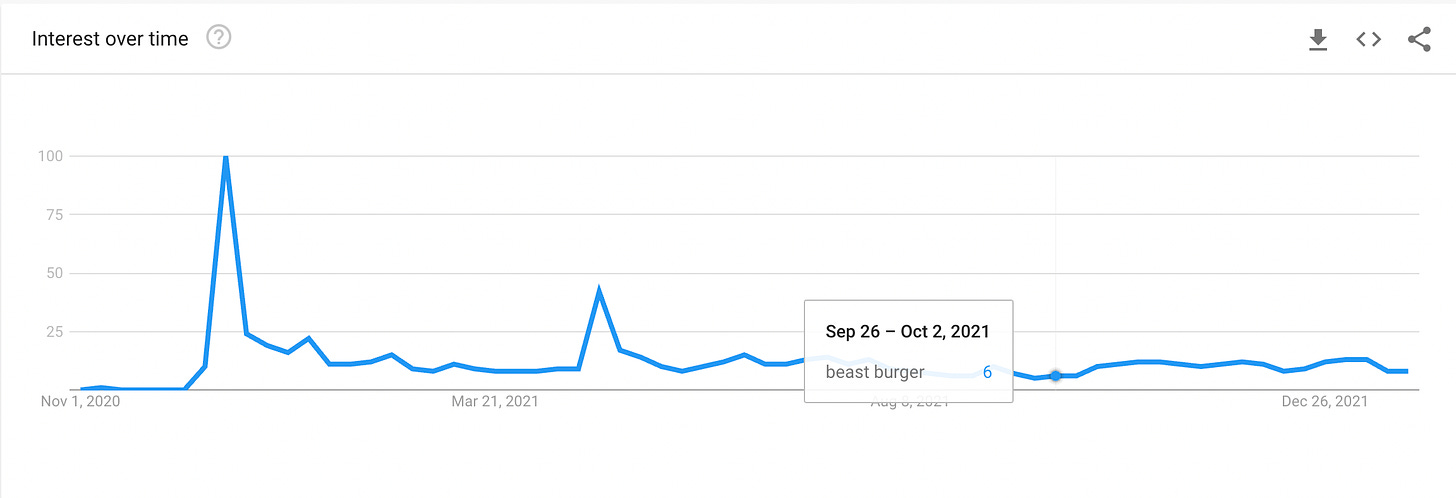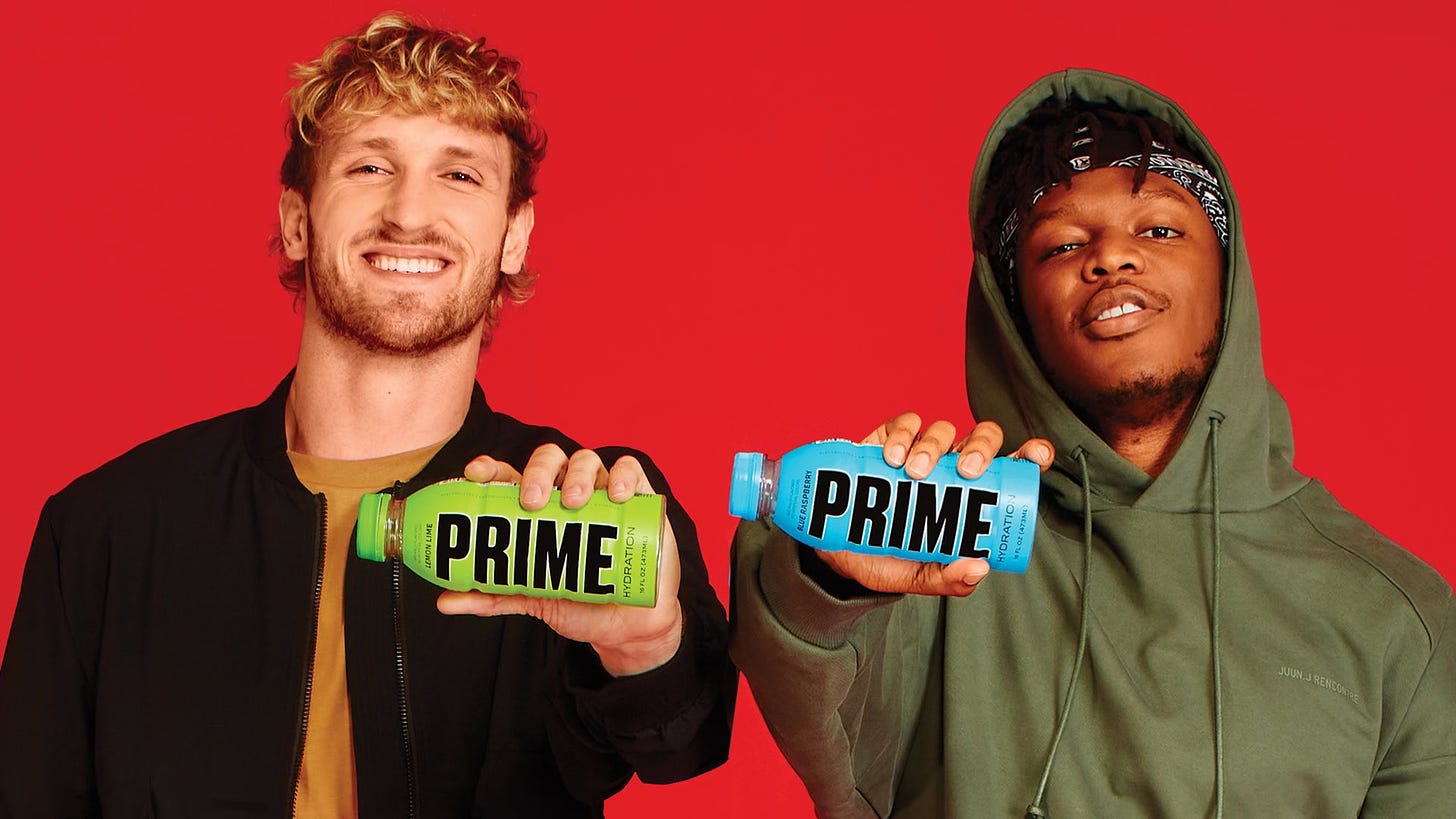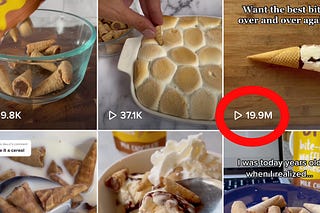

Discover more from Tommy Talks Marketing
🍫 How MrBeast Launched Feastables (Genius)
Breaking down the marketing behind MrBeast’s NEW ecom brand 📈
Hey friends. It’s time for a case study.
Last week, Jimmy Donaldson (better know as MrBeast) announced yet another major business move. He launched a DTC chocolate brand — Feastables.
Backed by several big-name investors and DTC operators, the product is Jimmy’s latest venture into ecommerce.
And the marketing behind it was genius. Today’s case study is a deep dive into what made this launch so special, and how you can apply these principles to your own brand.
(and no, you don’t need to have 89.2M subscribers to apply these)
Today at a glance:
How Feastables leveraged MrBeast’s audience in a unique way to drive initial purchases
A deep dive into the content marketing masterclass MrBeast put on during this launch
Breaking down key elements of the Feastables landing page that helped drive conversions
Questions + concerns about the brand going forward?
If you’re new around here, take 13 seconds to subscribe for case studies about marketing in ecommerce and the creator economy:
How MrBeast Created A Buying Frenzy for Feastables On Launch Day
Before we get into this, I want to address something. This isn’t a breakdown of how “healthy” the product is, or is not. This is a breakdown of the marketing and content stategy around the launch.
So... please take that argument somewhere else. Deal?
Now, the first stroke of genius in the Feastables launch strategy. Each MrBeast bar purchased is a chance to win a “Mystery Ticket.” Only 10 of these tickets exist, and each represents the opportunity to be featured in a MrBeast video remaking Willy Wonka’s Chocolate Factory in real life.
There are a few driving forces behind why this approach works:
First, the promotion strategy is relevant to the creator. Feastables isn’t just betting on MrBeast having a massive audience, like many creator-led brands do. They provided something desirable to the audience the incentivize the initial purchases. Anyone who’s a die-hard fan of MrBeast would jump at the chance to be in a video.
This promotion also taps into the fans’ desire for social status. Think about it. If you were a diehard MrBeast fan, being featured in one of his videos is the ultimate bragging right.
Feastables also used real scarcity to drive participation in this promotion. There are only 10 tickets available. No more, no less. To have the best chance of making it into Jimmy’s video, fans will jump on buying the product early.
On top of that, more purchases means more entries. All you need to do is buy more chocolate. This created a surge of buyers on day 1 of the launch.
The brand is using Jimmy’s clout as a creator to drive that initial purchase, and betting on the product actually tasting good. If the product is legit, that opens the door for repeat purchases.
And if the clout of being in a MrBeast video isn’t enough... Jimmy also gave away roughly $1M in prizes like Teslas, PS5s, customized PCs, and more to incentivize purchases.
The question is: what keeps this strategy from coming off like a gimmicky sweepstakes?
This offer works because it’s on-brand for Jimmy. He’s known for given away ridiculous prizes.
Just scroll through his channel and you’ll see him:
Giving away Lamborghini’s
Buying people houses
Consistently giving away obscene amounts of cash
On a recenter episode of Creator Economics, Jimmy’s manager, Reed Duchscher referred to this business model as gamified commerce. Has a nice ring to it.
TLDR: His audience already knows him for this type of content, so Feastables feels authentic.
Now, how is it different from other chocolate?
No more boomer chocolate...
Every story needs a villain. If you read my case study on Logan Paul’s PRIME drink, you’ve already seen this in action. Logan and KSI positioned Gatorade as the bad guy in their quest to build a beverage brand. This positioned the brand as an underdog, fostering even more support from their fanbase.
The villain in this case?
Boomer chocolate.
What does that mean? Honestly, no clue.
What matters here is that there’s a clear “other.”
“Boomer” refers to the Baby Boomer generation. It’s evovled into a way for Gen Z to refer to someone as old, or out of touch. If you didn’t know that, you may be a boomer (sorry, I don’t make the rules).
Remember, the majority of Jimmy’s audience is younger and in that Gen Z demographic. Young people want to feel cool. Acting like a “boomer” is the opposite of that.
So, positioning Feastables as the antithesis of “boomer” chocolate, the brand is more appealing to the target audience and alienates a group that wouldn’t have bought anyway.
Mission accomplished.
Now… I said we weren’t going to discuss the nutritional value of the product. I lied.
The “better for you” angle is an interesting call. With 13g of added sugar, and sugar being the primary ingredient, some critics are rightfully concerned about Feastables being sold as a health food.
Honestly, I see both sides of the argument here. I believe it comes down to whether Feastables is advertised as “healthy,” or simply better for you than other forms of chocolate.
No matter what way you look at it, a chocolate bar with its main ingredient being sugar isn’t healthy. But, this product may be a better alternative thank a Hershey’s or Snickers bar.
If that’s the angle, I can get behind it. But Feastables as a health food? Not quite.
And on top of that, the age of Jimmy’s main demographic makes this a gray area, especially with the “paying you to eat chocolate” angle mentioned above.
Theres’s room to debate regarding the ethics of the brand positioning, but it doesn’t take away from the effectiveness of it (and what we can learn as marketers).
Now, let’s take a look at how Feastables used content to create massive amounts of awareness for the brand on day one.
A Deep Dive Into The Social & Content Strategy + Execution
I get it. A lot of these breakdowns of creator-led brands come down to the same conclusion:
“Build a large, engaged audience to sell your product to.”
That’s true. But, that’s just the start. Once you have the audience, you have to execute the launch of your brand in the right way. For creators, that means introducing your product in a way that’s authentic to your brand — and that doesn’t make it look like just another cash grab.
And I can’t think of anything more authentic to Jimmy’s brand than a ridiculous IRL challenge video.
To announce the launch of Feastables, Jimmy included the brand in his newest video: “World’s Most Dangerous Escape Room.”
This was different than a lot of launch announcements that you seem from creators. The video’s title and thumbnail didn’t even mention the product. Jimmy did’t plug Feastables until over four minutes into the video.
And when he did, it didn’t disrupt the flow of the content at all. It was integrated into the content as a feature in the “escape room” challenge that was underway.
During the announcement portion of the video, Jimmy also used a series of visual and audio pattern interrupts to keep the viewer engaged until the rest of the video began. The editor used quick cuts, visuals of the product, sound design, and more to keep the sponsored part of the video fast paced enough to avoid and excess bounce rate. Super smart.
On top of that, there were parallels between the challenge in the video itself and the Feastables “Mystery Ticket” promotion. The contestants in the escape room challenge had to search for a mystery ticket to get them out of the room... just like fans at home would be searching for the mystery ticket.
One of the things I love about MrBeast’s approach to content in general is that there are so many rabbit holes to go down. It feels like every segment, ever edit, every word is engineered with a purpose.
YouTube aside, let’s take a lot at other social platforms. The approach on Twitter, Instagram, and TikTok were definitely more direct. Let’s take a look 👇
The copy is simple, authentic, and emphasizes the main feature of the product that is likely to drive the most purchases. The imagery stands out, displays the product, and shows the easily recognizable MrBeast. Textbook.
Another small, but important nuance to note. The copy is specific to each platform. On Twitter, Jimmy prompts the users to click the link in the tweet. On IG, Jimmy prompts the users to click the link in his bio. You’d be surprised how many brands screw this up.
Also, on IG the post uses a carousel. This isn’t make or break, obviously. But it’s a small practice that can lead to a bit more visibility on the platform. And at Jimmy’s scale, that extra visibility can drive several extra purchases.
The TikTok video is simple, and effective for many of the same reasons mentioned above in the YouTube video — a strong hook, quick cuts, visuals, etc to keep the viewer engaged.
It also covers all of the value props of the product in just 30 seconds: the chance to win prizes, the taste of the product, and the quality ingredients.
Feastables x PRIME
Days after the launch, this video was also posted on TikTok, IG, and Twitter:
Creators launching brands opens up the opportunity for cross promotion via social content, just like this. I’m a fan of how Jimmy and Logan viewed this as an opportunity to grow simultaneously, and not as competition.
The real competition for creator-led brands are legacy companies like Hershey’s Nestle, Gatorade, etc.
UGC galore
On top of Jimmy’s content, the nature of this product also opens up the opportunity for tons of user-generated content (UGC). Over the coming weeks, expect to see loads of review videos hit YouTube and TikTok. This generates more awareness for the product.
(Btw, if you want to create a review video for Feastables, that’s a good opportunity to capitalize on a trending topic and get some viewership to your own channel).
📈 By the numbers
As of writing this piece:
The launch YouTube video has 31,683,765 views
The launch tweet has 8,900 retweets and 157,200 likes
The launch IG post has 1,644,221 likes
The launch TikTok has 3,900,000 views and 514,000 likes
Crazy engagement. That’s the power of creator-led brands.
Now, let’s look at how Feastables capitalized on that engaged audience with proper ecom fundamentals.
Feastables Landing Page Teardown
The landing page for Feastables is so, so good.
The main focus here isn’t going to be the aesthetics (mainly because I’m the furthest thing from a designer). We’re going to focus on the main elements of the landing page and copywriting in this piece.
Upon landing on the site, you’ll see that all of the important information a consumer would need is presented above the fold:
A large, clear visual of the product in action
A relevant list of the top 3 benefits of the product
A noticeable CTA for visitors to shop for the product
The page is also optimized for mobile, given that a large percentage (likely more than half) of the traffic to this site on launch day came from mobile off of YouTube, Twitter, IG, and TikTok. Each of those 3 elements are clearly visible, no matter the platform.
The benefits listed also address 3 different subsections of the target audience:
Tastes delicious ⇒ customers who are driven by taste
Only 4 base ingredients ⇒ customers who are driven by health
Win $1,000,000 in prizes ⇒ customers who are driven by money + clout
You’ll also see a sticky header at the top of the page, giving customers yet another reason to by.
For orders above $88, customers get free shipping, and a free T shirt. This offer is likely meant to drive a higher AOV (average order value) for the product.
The T shirt also serves as advertising for the brand itself when customers wear it in public. Will this drive a massive amount of sales? Maybe, maybe not. But regardless, it’s a nice bonus for the customer.
Upon scrolling, you’re met with more copy and design that emphasizes the giveaway and chance to win crazy prizes. The copy also emphasizes that more purchases means more entries into the competition. Repetition is powerful in copywriting.
Again, Feastables seems to be betting on the giveaways to get the customer in the door. It makes sense because this is the angle that likely appeals to the largest segment of Jimmy’s audience.
Now, this next part is interesting. The “reviews,” that weren’t actual reviews. Rather, the reviews section was populated with copy that was made to seem like it came from members of Jimmy’s crew.
Jimmy’s built so much trust and loyalty over the years that his endorsement alone is enough social proof. Of course, as Feastables get into the hands of actual consumes, I would think we’ll start to see real reviews on the website.
The landing page also emphasized that Feastables would be donated to various charities:
After hitting on the money, “health,” and taste angles, the charity angle covers yet another way to reach the largest percentage of Jimmy’s massive audience.
And if visitors choose not to buy right away, a pop up incentivizes an SMS opt-in.
Interesting to note that the main pop-up only focuses on SMS, not email. This is likely because of the age of Jimmy’s target demo. Kids, teens, and young adults are likely easier to reach via text.
Anything else you’d add? Let me know in the comments.
Now…
Is Feastables’ Momentum Sustainable?
Look, no launch is perfect. No product is perfect. There are still questions that need to be answered when it comes to Feastables.
The main unknown right now is how the brand plans to continue growing after the IRL Willy Wonka video, and the related hype, passes.
Let’s look at Beast burger, for example. According to Google Trends, there was a massive spike in interest in December 2020, around launch.
After that, there was a significant drop-off and one other small spike in 2021. Of course, this doesn’t give insight into revenue numbers. But, it’s worth considering.
It’s also worth comparing the product to PRIME, another creator-led brand launched by Logan Paul and KSI. In my opinion, PRIME feels a bit more in line with the Logan’s personal brand than Feastables is with MrBeast’s (the product itself, not the promotion strategy).
There’s a real story behind PRIME’s inception during Logan’s fight camp. And assuming Logan (or Jake) continues to box, the drink remains relevant to the content.
Feastables begs the questions: What does MrBeast know about chocolate? Does the product even taste good?
Back to Beast Burger, there were several concerns about quality of the food. Customers posted pictures of under- and overcooked burgers, and there seemed to be a lack of consistency early on.
With Feastables being a packaged good and fully owned by MrBeast (rather than a joint venture with cloud kitchens), quality assurance is likely much more practical. Still, these are valid concerns.
The primary question around the brand is whether Feastables is a brand that Jimmy plans to continue scaling, or if it’s a one-time thing that’s leveraging the YouTube video.
I’m betting on the former, because of the investors and operators involved in it:

Not to mention, the brand went and hired Jim Murray, the former CEO of RX Bars. All of their moves indicate that this is a massive long-term play.
Additionally, on the aforementioned episode of Creator Economics, Jimmy’s manager clarified that Feastables is not a chocolate company — it’s a snacks company.
Chocolate, in conjunction with the gamified commerce approach, was just the hook to create initial momentum for the brand. With that frame of reference, I’d consider the Day 1 of the launch a massive success.
Congratulations to the Feastables team and everyone else involved. I’m excited to see how Feastables plans to carry this momentum into the months and years to come.
Only time will tell.
The Big Picture for Creator-Led Brands
Feastables isn’t the first creator-led brand we’ve seen, and it certainly won’t be the last.
In January alone, we’ve seen YouTube superstars Logan Paul and KSI launch their own beverage company, PRIME.
We’ll continue to see more massive creators. like MrBeast, Logan Paul, KSI, Emma Chamberlain, and more continue to launch brands like this.
Why?
Creators are able to build high levels of trust with their audience. When that trust is met with an authentic product that the creator truly believes in, it leads to purchases with minimal money spent on advertising.
Creators also have a built-in content engine to promote their product. And more importantly, they have a deep understanding of how to create content that their audience wants. This is a super power when it comes to promoting a product.
Looking Feastables, the only paid media I found was a simple branded keyword ad targeting “feastables.” This was likely to make sure that the brand capitalized on anyone who went to Google after seeing Jimmy’s announcement post. Other than that, the launch was carried by Jimmy’s built-in audience.
The combination of a good product + the cult-like loyalty these creators have manufactured over years of publishing content also opens the door to higher customer LTV.


One aspect of the Feastables launch that stood out to me was Jimmy’s initiative to partner with proven ecom operators to launch this.
As we saw with the brand positioning, the offer, the content strategy, the landing page, etc... the launch was executed with near flawless ecommerce fundamentals.
This allowed Jimmy to get the maximum return on the massive amount of attention he’s garnered over the years.
In the coming years, I suspect we’ll see more and more big (and relatively smaller) creators working with marketers to get brands off the ground.
Real quick... one more thing 👇
If you enjoyed this case study, and want to stick around for future editions, you can sub for free here:
Every week I send you a newsletter that’ll help you create better content and market your brand more effectively.
Talk to you next week,
Tommy
PS - I put hours every week into these articles, so if you find these helpful... sharing this with another founder or marketer you know would mean the world. Appreciate you!




